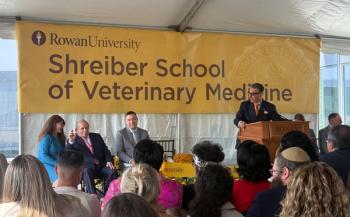
Diagnosis and classification of equine muscle disorders (Proceedings)
Evaluation of the muscular system includes inspection for symmetry of muscle mass while standing square. Prior to palpation evidence of fine tremors or fasciculations should be noted. Palpate entire muscle mass for heat, pain, swelling or atrophy comparing contra lateral muscle groups.
In general, muscle disorders fall into one of four categories:
I. Those that involve muscle fasciculations – either physiologic in basis, or resulting from abnormal electrical conduction within the muscle
1. Pain, fear
2. Electrolyte abnormalities (hypocalcemic tetany)
3. Hyperkalemic periodic paralysis
4. Otobius Megnini ear tick infestation
5. Myotonia
II. Those that involve muscle atrophy
a. Myogenic atrophy
• Disuse
• Pituitary dysfunction
• Immune-mediated myositis
b. Neurogenic atrophy
• Equine Protozoal Myelitis
• Local nerve trauma
• Equine Motor Neuron Disease
III. Those that involve muscle necrosis (rhabdomyolysis)
A. Non-exercise associated rhabdomyolysis:
a. Inflammatory myopathies
• Clostridial myositis
• Equine Influenza and herpesvirus 1
• Sarcocystis myositis
• Streptococcus equi myopathy
• Infarctive purpura hemorrhagica
• Immune mediated myopathy with atrophy
b. Nutritional myopathy
• Vitamin E or selenium deficiency
c. Toxic myopathy
• Ionophore toxicity
• White snake root or rayless goldenrod
• Vitamin D simulating plants (Casea sp.)
• Pasture Myopothy
d. Traumatic myopathy
• Anesthetic myopathy
• Trauma
• Compartment syndrome
• Capture myopathy
e. Metabolic myopathy
• Glycogen branching enzyme deficiency (Quarter Horses)
• Polysaccharide storage myopathy
• Malignant hyperthermia
B. Exertional Rhabdomyolysis (increased CK, associated with exercise)
a. Sporadic Tying-up (historically first episode, normal AST)
• Dietary imbalances in vitamins, minerals, electrolytes
• Excess carbohydrate
• Low vitamin E/Se
• EHV-1
• Overexertion
• Sustained endurance exercise
b. Chronic Tying-up
• Polysaccharide storage myopathy (genetic test/biopsy diagnosis)
• Recurrent exertional rhabdomyolysis (biopsy diagnosis)
• Idiopathic chronic exertional rhabdomyolsis
IV. Those that involve muscle dysfunction with normal CK
a. Mitochondrial myopathy (persistent lactic acidosis with light exercise)
b. Hyperkalemic periodic paralysis
EVALUATION OF SKELETAL MUSCLE
History:
History of stiffness, muscle cramping, pain, muscle fasciculations, exercise intolerance, weakness or muscle atrophy may implicate a muscle disorder. Useful information includes a detailed account of the exercise schedule, diet, and vaccination history, signs of respiratory disease, duration, severity and frequency of muscle problem, any factors that initiate the muscle problem (stress, lameness, exercise) and all medications the animal is being treated with.
Physical Examination:
Evaluation of the muscular system includes inspection for symmetry of muscle mass while standing square. Prior to palpation evidence of fine tremors or fasciculations should be noted. Palpate entire muscle mass for heat, pain, swelling or atrophy comparing contra lateral muscle groups. Firm deep palpation of the lumbar, gluteal and semi-membranosus/-tendinosus muscles may reveal pain, cramps or fibrosis. Stimulation of lumbar and gluteal muscles should induce ventroflexion and dorsiflexion in healthy animals. Percuss pectoral, triceps and semitendinosus muscles using hammer or fist. A persistent cramp, dimpling of the muscle, or fasciculations following this may indicate a conduction system disturbance within the muscle. Movement examination should include observation at a walk and trot for any gait abnormalities. Observe for weakness, which can present as fasciculations, knuckling, frequent recumbency with difficulty rising, and shifting weight due to inability to fix the stifles. Weakness generally does NOT cause ataxia unless quite severe. Lameness evaluation (flexion tests) should also be performed as lameness may cause muscle pain as a secondary phenomenon.
Ancillary Diagnostic Tests:
Muscle Enzymes: Useful for determining if skeletal muscle damage has occurred.
Creatine kinase (CK) is muscle specific and indicates recent muscle degeneration. It rapidly increases and declines in serum, peaking 4-6 hrs after muscle damage. Mild elevations (= 1000 U/L) can be seen with training, recumbency, intramuscular injections, transport and strenuous exercise. Persistent elevation indicates ongoing myonecrosis. CK is labile so samples must be run the same day or frozen (and run within 48 hours).
Lactate dehydrogenase (LDH) is not muscle specific and may increase with liver disease. Peaks about 12 hrs after muscle damage and takes 7 to 10 d to clear from serum.
Aspartate aminotransferase (AST, SGOT) is not muscle specific and may increase with hemolysis, liver disease, or other organ damage. Peaks 24 - 48 hrs, declines over ~ 14d.
Urinalysis: Free catch from non-tranquilized horses if possible. Examine if suspicion of myoglobinuria, renal disease or in cases of exertional rhabdomyolysis where a dietary electrolyte or mineral deficiency might play a role. A positive blood reaction on a urine dipstick may mean hemoglobin, myoglobin or intact red cells, which should be differentiated .
Fractional excretion of electrolytes and minerals in the urine (FEx %) can be determined by the following equation, if blood and urine are obtained in close proximity in time:
FEx% = SCr x UX x 100
UCr x Sx
Where U and S = urine and serum respectively, x = measured electrolyte and Cr = creatinine. Normal values for horses on grass hay and sweet feed diet are FeNa: 0.04 to 0.08%; FeK: 35-80%; FECl: 0.4-1.2%; FECa: 5.3-14.5 %; FEP: 0.05 to 4.1%; FEMg: 14.2 to 21.4%.
Exercise response test: Measures the response of muscle enzymes to exercise. First obtain a resting serum sample for CK analysis, then have the horse perform 5 to 30 mins of trotting on a lunge line or treadmill. Obtain a 2nd 4 -6 hrs after exercise ceases and compare with first sample. Normally < 3 - 4 X increase in CK is found. NB. the test may elicit subclinical and sometimes severe muscle damage in horses with exertional myopathies. If clinical evidence of stiffness, pain, short stride and reluctance to continue occurs the test should be stopped. The test should NOT be performed in horses with current clinical evidence of rhabdomyolysis.
Further laboratory evaluation
Additional information can be obtained from CBC, blood gas analysis and other tests.
Dehydration: Hematocrit and total protein
-Renal function: Urinalysis, serum BUN and creatinine, urine:electrolyte clearance
-Acid-base status: alkalosis common with exertional rhabdomyolysis
-Serum electrolytes: Na, K, Cl, Ca, Mg, P (derangements can occur with severe rhabdomyolysis or in specific conditions such as HYPP)
-Vitamin E (serum) and selenium (EDTA blood) concentrations
-Whole blood glutathione peroxidase activity (EDTA blood)
Genetic testing
Available for type 1 Polysaccharide storage myopathy (PSSM), malignant hyperthermia and Glycogen branching enzyme deficiency (GBED) using hair or whole blood. Tests are available at the Genetics Laboratory, University of California, Davis (
Muscle biopsies
Histological evaluation of skeletal muscle can help to further characterize the muscle lesion. Sections can be prepared from formalin fixed or frozen sections. Formalin fixed sections can be examined for inflammatory infiltrates, necrosis, regeneration, central nuclei (abnormal) and proliferation of connective tissue. Optimal evaluation is achieved by using frozen sections that are prepared for histochemical evaluation. Examination of frozen sections can give further information about muscle fiber type and distribution pattern, differentiation between neurogenic and myogenic atrophy, characterization of inclusion bodies and vacuolar storage material, and assessment of mitochondrial density etc. Preparation and evaluation of frozen sections requires processing by a lab that specializes in muscle histochemistry. If such a lab is nearby a gluteal muscle sample can be obtained using a 6 mm diameter Bergstrom biopsy needle. When overnight shipping is necessary a larger sample of semimembranosus muscle (1/2 inch cube) can be collected and wrapped in saline dampened gauze and shipped overnight chilled to be frozen at arrival the lab. The disadvantage of the latter technique is the healing time required (2 weeks).
Electromyography (EMG)
In normal skeletal muscle, EMG detects little to no spontaneous activity after resolution of the insertion potentials elicited by needle placement, unless there is normal electrical activity from placement of a needle very close to a motor end plate or there is recruitment of motor units (action potentials) from muscle contractions. Animals with abnormalities in the electrical conduction system within muscle or denervation of motor units will show abnormal spontaneous electrical activity including complex repetitive discharges, myotonic discharges and positive sharp waves. Denervated muscle will show spontaneous electrical activity largely characterized by fibrillation potentials and positive sharp waves. EMG therefore confirms the presence and location of neuropathy or myopathy but may not help specifically establish the disorder present beyond diseases with very well defined and specific EMG anomalies such a myotonia. EMG can provides information that can be used to select further diagnostics such as nerve conduction tests or the most suitable site for nerve or muscle biopsy.
Ultrasonography: Useful for identification of muscle trauma, crepitus, fibrosis and atrophy. Normal muscles have a fairly uniform echogenic pattern with echodense bands of fascia running throughout. Contralateral muscle can be used for comparison when a lesion is suspected. Disruption of muscles with acute injury appears as hypoechoic regions in the muscle with loss of normal striation. Hematomas may appear as loculated regions. The muscle becomes more echogenic as it repairs and may develop regions of mineralization.
Thermography and Scintigraphy: Quantitates the amount of heat produced over different areas of the body. Not commonly used but presents a simple means of determining involved muscle groups. Scintigraphy has also been used to document involved muscle groups.
Newsletter
From exam room tips to practice management insights, get trusted veterinary news delivered straight to your inbox—subscribe to dvm360.






